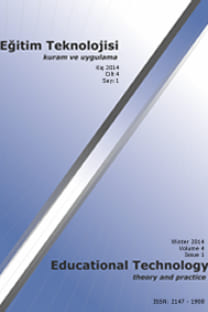ICT Integration Into Geometry Instruction: Reflections from a Mixed-Model Inquiry
Bu araştırmanın amacı bilgisayar destekli öğretim uygulamalarının öğretmen adaylarının geometri başarıları üzerindeki etkisini ve yazılım destekli geometri öğrenme ve öğretmeye yönelik görüşlerini belirlemektir. Nitel ve nicel verilerin aynı süreçte toplanmasından ötürü çalışma paralel-simültane karma model bir araştırma olarak desenlenmiştir. Araştırmanın çalışma grubunu Eskişehir Osmangazi Üniversitesi Eğitim Fakültesi İlköğretim Matematik Öğretmenliği Programı'nda öğrenim gören dördüncü sınıf öğrencisi 30 katılımcı oluşturmuştur. Çalışmanın sonuçları deneysel desen kapsamında toplanan verilerden nicel olanların çözümlenmesi sonucunda, Geometer's Sketchpad (GSP) ders uygulamalarının öğretmen adaylarının geometri başarılarını arttırmada ön test son test puan ortalamalarında anlamlı farklılık yaratmıştır. Nitel yordamın izlendiği bölümde ise gerek araştırmacı günlüğü gerekse katılımcıların görüşlerinde yazılım etkinliklerinin ve çalışma yapraklarının yeterli görüldüğü, özellikle kanıtların gösteriminde yararlı olacağı görüşünün hakim olduğu ortaya çıkmıştır. Araştırmacı tarafından işe koşulan öğrenci merkezli bilgisayar destekli yöntem olumlu karşılanmış, katılımcılar yazılım dili, tanıtım haftalarının kısalığı ve fiziksel şartların yazılım uygulamalarını etkileyen unsurlar olduklarını belirtmişlerdir. Katılımcılar aynı zamanda yazılım etkinlikleri ve çalışma yapraklarının düzenlenme biçiminin öğretmen olduklarında kendi seçecekleri öğretim anlayışını etkileyeceğini belirtmişlerdir.
Anahtar Kelimeler:
Bilgisayar destekli öğretim, karma model incelemesi, geometri öğretimi
ICT Integration Into Geometry Instruction: Reflections from a Mixed-Model Inquiry
This study aimed to investigate the effects of computer aided instructional applications on mathematics teacher candidates' geometry success and determine their perceptions on learning and teaching geometry supported by software. The study is a parallel-simultaneous mixed method research due to use of qualitative and quantitative data together. Within the scope of the research conducted, 30 teacher candidates attending Department of Elementary Mathematics Education at Eskişehir Osmangazi University Faculty of Education were selected as the participants of the study. The results of the research show that Geometer's Sketchpad (GSP) course applications ensure teacher candidates to increase their geometry success with also respect to t-test results. It is understood teacher candidates find the software activities and spreadsheets sufficient, especially in demonstration of proofs. The computer aided –student centered instructional method used in this research takes positive reaction by the candidates and software language, tutorial time and the physical characteristics of schools take attention as the critique aspects of applying software tutorials. The participants also noted that the way of development of software activities and spreadsheets affects the way of choosing suitable approach for the instruction.
___
- Baki, A. & Öztekin, B. (2003). Excel yardımıyla fonksiyonlar konusunun öğretimi, Kastamonu Eğitim Dergisi, 11(2), pp.325-338.
- Baytak, A., Tarman, B. & Ayas, C. (2011). Experiencing technology integration in education: children perceptions. International Electronic Journal of Elementary Education, 3(2),pp.139-151.
- Çetin, Ü. (2007). ARCS motivasyon modeli uyarınca tasarlanmış eğitim yazılımı ile yapılan öğretimle geleneksel öğretimin öğrencilerin başarısı ve öğrenmenin kalıcılığı açısından karşılaştırılması, Master of Science Thesis, Gazi University Graduate School of Educational Sciences, Ankara.
- Dixon, J.K. (1995). Limited English proficiency and spatial visualization in middle school students' construction of the concepts of reflection and rotation, The Bilingual Research Journal, 19(2), pp.221-247.
- Divaharan, S. (2011). Learning new technology tools in pre-service teacher education: A model for instructional approach. In G. Williams, P. Statham, N. Brown & B. Cleland (Eds.), Changing Demands, Changing Direction-Proceedings ASCİLİTE Hobart 2011. pp.352-363.
- Herron, J. (2010). Implementation of technology in an elementary mathematics lesson:The experiences of pre-service teachers at one university. SRATE Journal, 19(1), pp.22-29.
- Hock, C.U. (2008). A practical framework for technology integration in mathematics education. Paper presented at the SEAMEO 2008 ICT Conference in Kuala Lumpur, Malaysia. Retrieved on May 22, 2011 from http://www.recsam.edu.my/ rndpdf/R&D%20Research%20Papers/Technology%20Integration%20in%20Mathema tics%20Education.pdf.
- Javeri, M. & Persichitte, K. (2007). Measuring technology integration practices of higher education faculty with an innovation component configuration map (ICCM). International Journal of Technology in Teaching and Learning, 3(1), 28-50.
- Joyce, B., Weil, M., Calhoun, E. (2000). Models of teaching. 6th edition, Allyn & Bacon.
- Koh, J.H.L. & Divaharan, S. (2011). Developing pre-service teachers’ technology integration expertise through the TPACK-Developing Instructional Model, Journal of Educational Computing Research, 44(1).pp.35-58.
- Patton, M. Q. (2001). Qualitative research and evaluation methods. Sage Publications, London.
- Rogers, E. (2003). Diffusion of Innovations. 5th ed. New York: The Free Press.
- Searson, M., Laferriere, T. & Nikolow, R. (2011). TWG 7: Barriers to successful implementation of technology integration in educational settings. EDUsummIT 2011. Retrieved on May 23, 2011 from http://downloads.kennisnet.nl/algemeen/ edusummit2011/7%20EDUsummIT%202011%20BarriersEssentials.pdf
- Sng, C. & Gribovskaya, S. (2008) Using a mixed methods research design to evaluate the student teaching experience. Retrieved on December 20, 2009 from http://www.allacademic.com/meta/p207592_index.html
- Titiz, O. (2005). Yeni öğretim sistemi. Zambak Publishing Educational Series, İstanbul.
- Tuluk, G. (1997). Logo-matematiğin öğretmen adayları üzerindeki etkileri, Master of Science Thesis, Gazi University Graduate School of Natural Sciences, Ankara.
- Turkey National Ministry of Education, (2009). Elementary school mathematics curriculum, Ankara.
- Ubuz, B. & Üstün, I. (2004). Geometrik kavramların Geometer’s Sketchpad yazılımı ile geliştirilmesi. Retrieved on March 18, 2008 from http://www.erg.sabancıuniv.edu./ iok2004/bildiriler/Isil%20Ustun.doc.
- Yıldırım, A. & Şimşek H. (2006). Sosyal bilimlerde nitel araştırma yöntemleri. Seçkin Publishing, Ankara.
- Yidana, I. (2007). Faculty perceptions of technology integration in the teacher education curriculum: A survey of two Ghanaian universities. Unpublished Doctoral Thesis, College of Education of Ohio University, OH. Retrieved on December 22, 2011 from http://etd.ohiolink.edu/send-pdf.cgi/Yidana%20Issifu.pdf?ohiou1178570000
- ISSN: 2147-1908
- Yayın Aralığı: 2
- Başlangıç: 2011
- Yayıncı: Tolga Güyer
